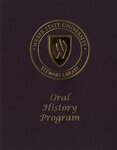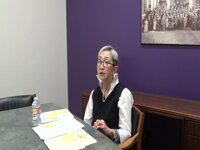| Title |
Oda, Linda OH19_024 |
| Creator |
Weber State University, Stewart Library: Oral History Program. |
| Contributors |
Oda, Linda, Interviewee; Harris, Kandice, Butler, Shannon, Interviewers; Thompson, Michael, Video Technician |
| Description |
The Beyond Suffrage Project was initiated to examine the impact women have had on northern Utah. Weber State University explored and documented women past and present who have influenced the history of the community, the development of education, and are bringing the area forward for the next generation. The project looked at how the 19th Amendment gave women a voice and representation, and was the catalyst for the way women became involved in the progress of the local area. The project examines the 50 years (1870-1920) before the amendment, the decades to follow and how women are making history today. |
| Abstract |
The following is an oral history interview with Dr. Linda Oda, conducted on two different days in the Stewart Library's Archives Conference Room. The first interview was conducted on August 19, 2019, and the second interview was conducted on August 22, 2019, by Kandice Harris and Shannon Butler. Linda discusses her life, her memories at Weber State University, and the impact of the 19th Amendment. Michael Thompson, the video technician is also present during this interview.; The following is a video clip of an oral history interview with Dr. Linda Oda discussing the importance of the 19th Amendment. |
| Subject |
Voting--United States; Women--suffrage; Women--Rights of women; Universities and colleges; Women in higher education; Universities and colleges--Faculty; Detention of persons; Japanese American families; Japanese American women teachers; Women school principals--United States |
| Keywords |
Japanese Americans; Ogden, Utah; 25th Street; Education; Diversity; Weber State University |
| Digital Publisher |
Stewart Library, Weber State University, Ogden, Utah, United States of America |
| Date |
2019 |
| Date Digital |
2019 |
| Temporal Coverage |
1944; 1945; 1946; 1947; 1948; 1949; 1950; 1951; 1952; 1953; 1954; 1955; 1956; 1957; 1958; 1959; 1960; 1961; 1962; 1963; 1964; 1965; 1966; 1967; 1968; 1969; 1970; 1971; 1972; 1973; 1974; 1975; 1976; 1977; 1978; 1979; 1980; 1981; 1982; 1983; 1984; 1985; 1986; 1987; 1988; 1989; 1990; 1991; 1992; 1993; 1994; 1995; 1996; 1997; 1998; 1999; 2000; 2001; 2002; 2003; 2004; 2005; 2006; 2007; 2008; 2009; 2010; 2011; 2012; 2013; 2014; 2015; 2016; 2017; 2018; 2019 |
| Medium |
oral histories (literary genre) |
| Spatial Coverage |
Brigham City, Utah; Ogden, Utah; Perry, Utah; Provo, Utah |
| Type |
Text; Image/StillImage; Image/MovingImage |
| Access Extent |
PDF is 121 pages; Video Clip is an mp4, 33.3 MB |
| Conversion Specifications |
Filmed using a Sony HDR-CX430V digital video camera. Sound was recorded with a Sony ECM-AW3(T) bluetooth microphone. Transcribed using Express Scribe Transcription Software Pro 6.10 Copyright NCH Software. |
| Language |
eng |
| Rights |
Materials may be used for non-profit and educational purposes, please credit University Archives; Weber State University; Music from Uppbeat (free for Creators!): https://uppbeat.io/t/yeti-music/gentle-breeze; License code: IWGKRYG7XHQOMZY0; Music from Uppbeat (free for Creators!): https://uppbeat.io/t/simon-folwar/hope; License code: KYI5VLB63GF1TXND |
| Source |
Oda, Linda OH19_024 Weber State University Archives |
| Format |
application/pdf; video/mp4 |
| ARK |
ark:/87278/s6at2jw5 |
| Setname |
wsu_bs_oh |
| ID |
105514 |
| Reference URL |
https://digital.weber.edu/ark:/87278/s6at2jw5 |
| Title |
Oda, Linda OH19_024 |
| Creator |
Weber State University, Stewart Library: Oral History Program. |
| Contributors |
Oda, Linda, Interviewee; Harris, Kandice, Butler, Shannon, Interviewers; Thompson, Michael, Video Technician |
| Description |
The Beyond Suffrage Project was initiated to examine the impact women have had on northern Utah. Weber State University explored and documented women past and present who have influenced the history of the community, the development of education, and are bringing the area forward for the next generation. The project looked at how the 19th Amendment gave women a voice and representation, and was the catalyst for the way women became involved in the progress of the local area. The project examines the 50 years (1870-1920) before the amendment, the decades to follow and how women are making history today. |
| Abstract |
The following is an oral history interview with Dr. Linda Oda, conducted on two different days in the Stewart Library's Archives Conference Room. The first interview was conducted on August 19, 2019, and the second interview was conducted on August 22, 2019, by Kandice Harris and Shannon Butler. Linda discusses her life, her memories at Weber State University, and the impact of the 19th Amendment. Michael Thompson, the video technician is also present during this interview. |
| Image Captions |
Linda Oda Circa 1964; Linda Oda Circa 2004; Linda Oda 22 August 2019 |
| Subject |
Voting--United States; Women--suffrage; Women--Rights of women; Universities and colleges; Women in higher education; Universities and colleges--Faculty; Detention of persons; Japanese American families; Japanese American women teachers; Women school principals--United States |
| Keywords |
Japanese Americans; Ogden, Utah; 25th Street; Education; Diversity; Weber State University |
| Digital Publisher |
Stewart Library, Weber State University, Ogden, Utah, United States of America |
| Date |
2019 |
| Temporal Coverage |
1944; 1945; 1946; 1947; 1948; 1949; 1950; 1951; 1952; 1953; 1954; 1955; 1956; 1957; 1958; 1959; 1960; 1961; 1962; 1963; 1964; 1965; 1966; 1967; 1968; 1969; 1970; 1971; 1972; 1973; 1974; 1975; 1976; 1977; 1978; 1979; 1980; 1981; 1982; 1983; 1984; 1985; 1986; 1987; 1988; 1989; 1990; 1991; 1992; 1993; 1994; 1995; 1996; 1997; 1998; 1999; 2000; 2001; 2002; 2003; 2004; 2005; 2006; 2007; 2008; 2009; 2010; 2011; 2012; 2013; 2014; 2015; 2016; 2017; 2018; 2019 |
| Medium |
oral histories (literary genre) |
| Spatial Coverage |
Brigham City, Utah; Ogden, Utah; Perry, Utah; Provo, Utah |
| Type |
Text; Image/StillImage |
| Access Extent |
PDF is 121 pages |
| Language |
eng |
| Rights |
Materials may be used for non-profit and educational purposes, please credit University Archives; Weber State University; Music from Uppbeat (free for Creators!): https://uppbeat.io/t/yeti-music/gentle-breeze; License code: IWGKRYG7XHQOMZY0; Music from Uppbeat (free for Creators!): https://uppbeat.io/t/simon-folwar/hope; License code: KYI5VLB63GF1TXND |
| Source |
Oda, Linda OH19_024 Weber State University Archives |
| Format |
application/pdf |
| Setname |
wsu_bs_oh |
| ID |
105717 |
| Reference URL |
https://digital.weber.edu/ark:/87278/s6at2jw5/105717 |





